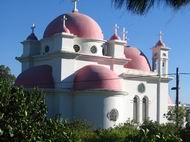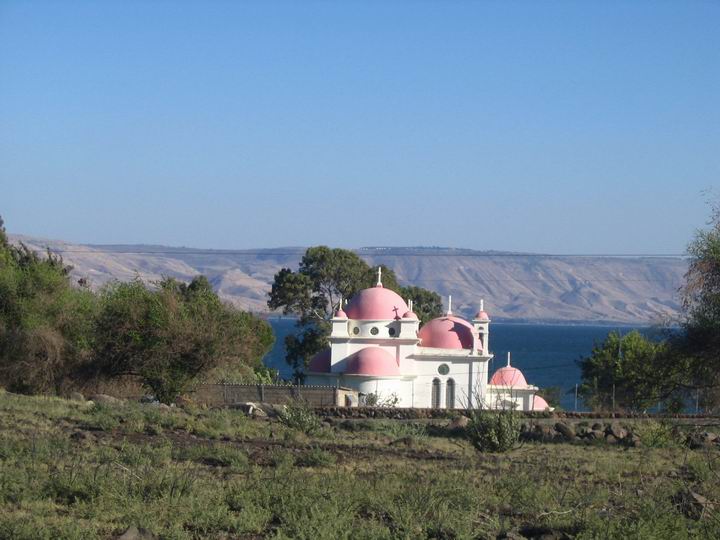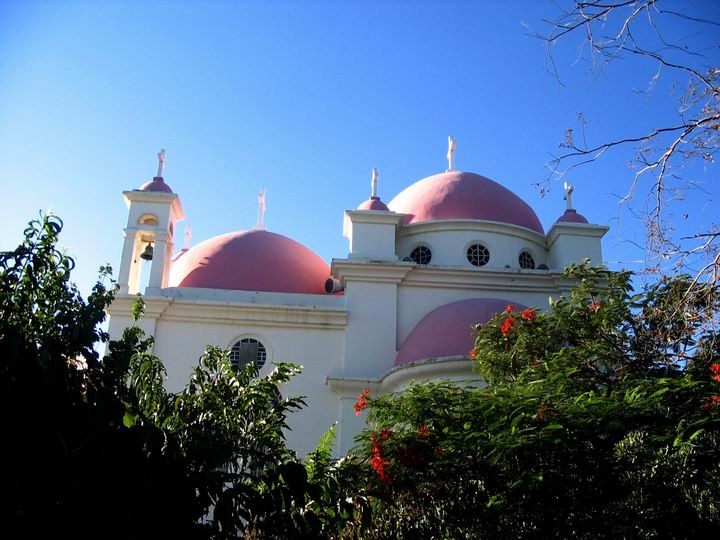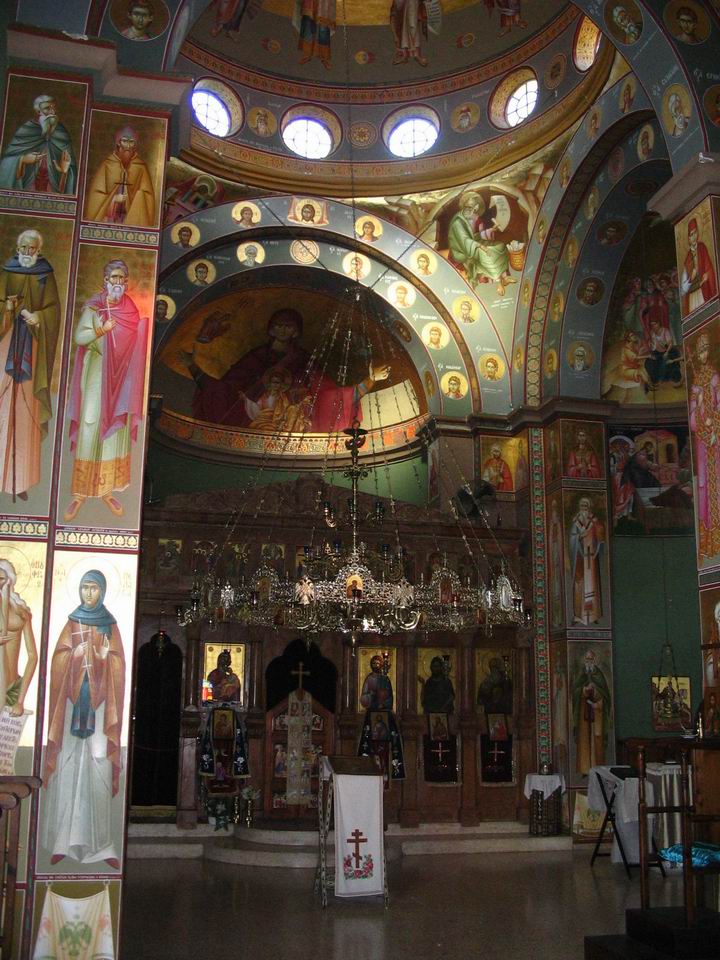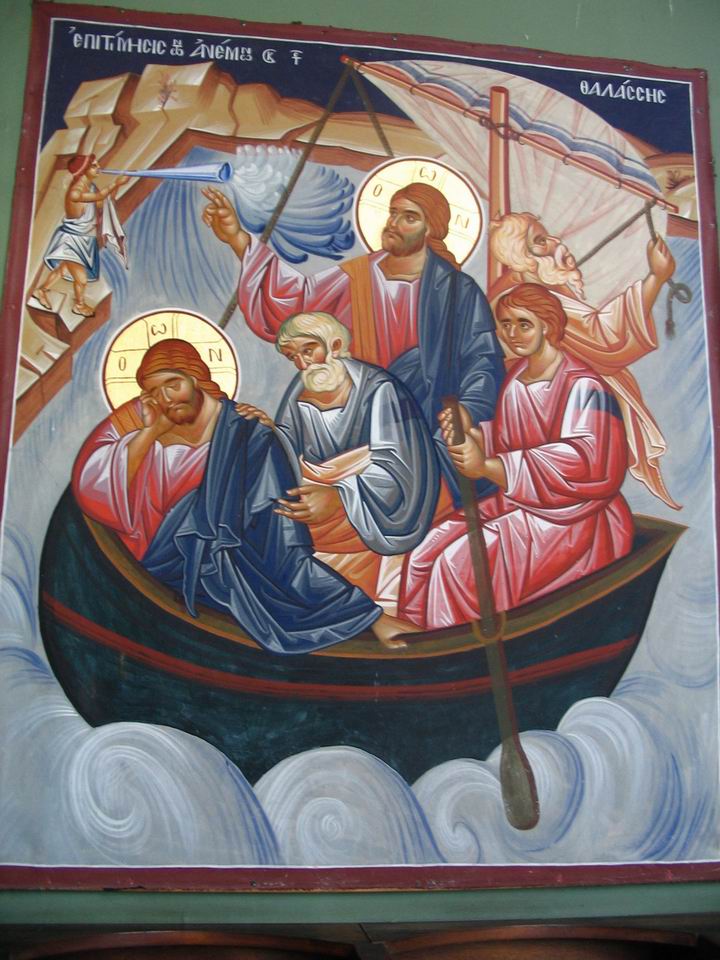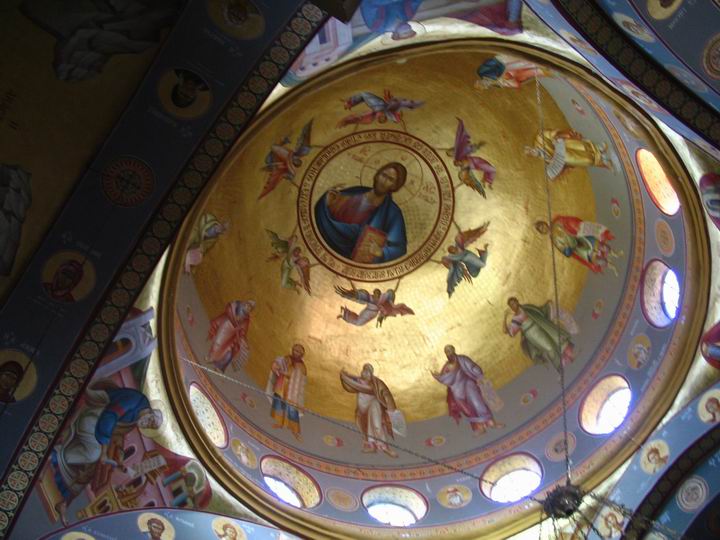The Greek Orthodox Church is a charming place in the site of the ancient village of Capernaum.
Home > Sites > Sea of Galilee > Capernaum > Greek Orthodox Church
Contents:
Location:
The area of the village of Capernaum is located at the north corner of the Sea of Galilee, on the side of the ancient road from Tiberias to the east of the sea of Galilee: Golan, Gamla and Jordan.
The Orthodox church is located on the eastern side of the ruined village, the home town of Jesus. The main center of the village is described in another page- see Capernaum.
Background:
Capernaum was the center of Jesus activities in the Galilee and his town during that time. Jesus taught in the local synagogue. It was also the home of the apostles Peter, James, Andrew and John, and the tax collector Matthew.
History:
The Orthodox church is built in the middle of the ruins of the ancient Roman village of Kfar-Nahum (Capernaum). Around the church the remains of the village have not yet been excavated, unlike the synagogue of Capernaum and the buildings around it. The area under the control of the Orthodox church is 1/3 of the entire ruins, which covers about 60 dunams (6 Hectares).
The village was established in the Hellenistic period, and was designed according to that period’s urban design of straight lines. Capernaum prospered in the Roman and Byzantine periods. It was destroyed in the Persian conquest in the 7th century AD.
Photos:
An aerial view, as captured from a quad copter from the northeast side, is seen in this photo. Ruins of the ancient Roman village of Capernaum are located around the site. On the left (west) side is the edge of the Franciscan compound.
Click on the photo to view it in higher resolution…
The following photo shows the charming looking Orthodox Church from the ground level, on its north side. The Sea of Galilee is in the background, and behind it the Golan Heights.
A view from the south… The garden facing the Sea is a great place to meet and have a picnic.
A look in the interior of the church.
Inside, there are many interesting items and paintings.
The miracle of the storm, which happened in the Sea nearby, is one of the paintings on the walls.
“And when he was entered into a ship, his disciples followed him. And, behold, there arose a great tempest in the sea, insomuch that the ship was covered with the waves: but he was asleep.
And his disciples came to him, and awoke him, saying, Lord, save us: we perish. And he saith unto them, Why are ye fearful, O ye of little faith? Then he arose, and rebuked the winds and the sea; and there was a great calm. But the men marvelled, saying, What manner of man is this, that even the winds and the sea obey him!”
(Reference: Matthew 8:23-27; also in: Mark 4:35-41, Luke 8:22-25)
The stained glass wall on both sides enter a magic ray of light into the church, as can be seen here.
The photo below shows the stunning ceiling:
Biblical References:
There are many references for Capernaum, which played an important role in the life of Jesus. The following are just samples:
(a) Mathew 4:13, 18:22
According to Mathew , Capernaum is “in the borders of Zabulon and Nephthalim”. Actually, it is in the middle of the area of Nephthalim, since Zabulon eastern border is in Mount Tabor.
“And leaving Nazareth, he came and dwelt in Capernaum, which is upon the sea coast, in the borders of Zabulon and Nephthalim”
The text continues to tells us that here in Capernaum Jesus chooses the fishermen as disciples:
18 “And Jesus, walking by the sea of Galilee, saw two brethren, Simon called Peter, and Andrew his brother, casting a net into the sea: for they were fishers. 19 And he saith unto them, Follow me, and I will make you fishers of men. 20 And they straightway left their nets, and followed him. 21 And going on from thence, he saw other two brethren, James the son of Zebedee, and John his brother, in a ship with Zebedee their father, mending their nets; and he called them. 22 And they immediately left the ship and their father, and followed him.”
(b) Mark 1:21
“And they went into Capernaum; and straightway on the sabbath day he entered into the synagogue, and taught.”
(c) Luke 4:31
“And came down to Capernaum, a city of Galilee, and taught them on the sabbath days.”
Historical References:
(a) Josephus Flavius (Antiquities of the Jews – Book III, 10, 8)
Josephus, the Commander of the Jewish revolt against the Romans, which turned to be the best historian for this time, writes about the area of the sea of Galilee and Capernaum:
“The country also that lies over against this lake hath the same name of Gennesareth; its nature is wonderful as well as its beauty; its soil is so fruitful that all sorts of trees can grow upon it, and the inhabitants accordingly plant all sorts of trees there; for the temper of the air is so well mixed, that it agrees very well with those several sorts, particularly walnuts, which require the coldest air, flourish there in vast plenty; there are palm trees also, which grow best in hot air; fig trees also and olives grow near them, which yet require an air that is more temperate. One may call this place the ambition of nature, where it forces those plants that are naturally enemies to one another to agree together; it is a happy contention of the seasons, as if every one of them laid claim to this country; for it not only nourishes different sorts of autumnal fruit beyond men’s expectation, but preserves them a great while; it supplies men with the principal fruits, with grapes and figs continually, during ten months of the year and the rest of the fruits as they become ripe together through the whole year; for besides the good temperature of the air, it is also watered from a most fertile fountain. The people of the country call it Capharnaum. Some have thought it to be a vein of the Nile, because it produces the Coracin fish as well as that lake does which is near to Alexandria. The length of this country extends itself along the banks of this lake that bears the same name for thirty furlongs, and is in breadth twenty, And this is the nature of that place.”
Etymology (behind the name):
- Capernaum – from Hebrew: Kefar (village) + Nachum (a name of the prophet from the old testament).
Links:
* Internal:
- Capernaum – main page
- Quadcopter Aerial views – collection of Biblical sites from the air
BibleWalks.com – walk with us through the sites of the Holy Land
Capernaum <<<–previous site—<<<All Sites>>>–-next Sea of Galilee site –>>> Tiberias
This page was last updated on Oct 5, 2014
Sponsored links:
